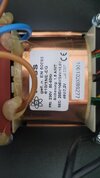InDecember
Registrierter Benutzer
- Zuletzt hier
- 19.09.22
- Registriert
- 22.08.22
- Beiträge
- 4
- Kekse
- 0
Hi, first off, this post is in English as I don't speak German very well, but I've seen a lot of good knowledge on this forum, so I thought I give this a shot. Should this not be allowed, please do remove this post. Feel free to respond in German if you want to.
So, I have this ENGL Savage 120 mk1 and ever since I bought new back in 2009 it is eating outputtubes for breakfast. I have to replace them every few months or so because one starts red plating, no matter how meticulous the bias is set (by me or by a tech).
In my search for a solution I came across a label on the powertransfo with the values of the sec windings printed on it. To my surprise it doesn't have the 6.3VAC (2x3.15) tap to feed the heaters, instead it has a 7.2VAC output. As far as I know ecc83's and 6550's are designed for 6.3VAC on the filaments. I measured this unloaded (no tubes) and get 7.54VAC on the heaters and loaded (tubes in place) gives me 7.01VAC. This seems way too high.
Is it normal for Engl to use these higher voltage transfo's and could this be a cause of red plating in the long term?
I did contact Engl directly, but didn't receive any reply to this day.
Cheers,
Erik
So, I have this ENGL Savage 120 mk1 and ever since I bought new back in 2009 it is eating outputtubes for breakfast. I have to replace them every few months or so because one starts red plating, no matter how meticulous the bias is set (by me or by a tech).
In my search for a solution I came across a label on the powertransfo with the values of the sec windings printed on it. To my surprise it doesn't have the 6.3VAC (2x3.15) tap to feed the heaters, instead it has a 7.2VAC output. As far as I know ecc83's and 6550's are designed for 6.3VAC on the filaments. I measured this unloaded (no tubes) and get 7.54VAC on the heaters and loaded (tubes in place) gives me 7.01VAC. This seems way too high.
Is it normal for Engl to use these higher voltage transfo's and could this be a cause of red plating in the long term?
I did contact Engl directly, but didn't receive any reply to this day.
Cheers,
Erik

